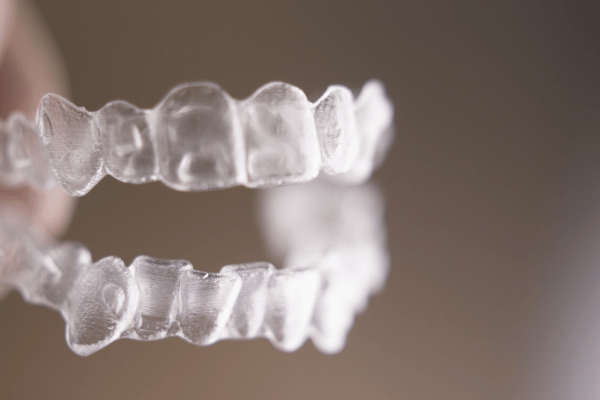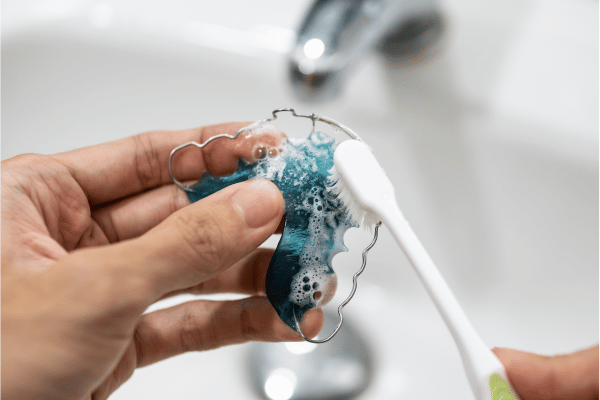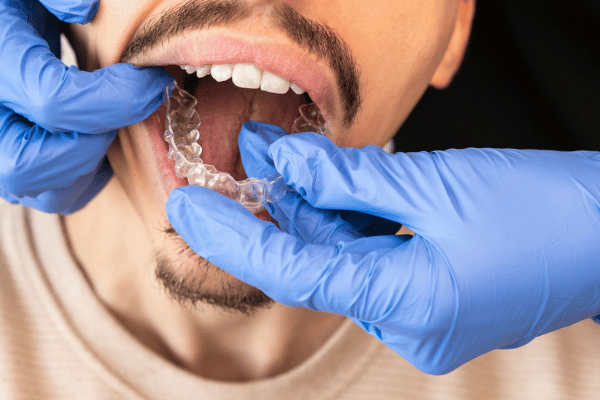The Crucial Role of Retainers After Braces
After the hard work of completing your teeth straightening journey, comes the crucial step of maintaining that perfect smile. Retainers are not just an option; they are a must-have for anyone who wants to keep their teeth straight and beautiful after braces. Think of your retainer as a best friend to your smile, keeping everything in place and ensuring your teeth don’t go back to their old ways.
Retainers in post-orthodontic care play a crucial role.. Once braces are removed, teeth can naturally start to shift back to their original position. This is where retainers come in. They hold your teeth in their new, correct positions and ensure that all the time, effort, and investment you put into having braces pay off in the long run. Do you need retainers after braces? Absolutely. They are your smile’s best protection against moving teeth.
Types of Retainers After Braces: Clear vs. Metal
When it comes to retainers, you have options, and each type comes with its own set of benefits. The two main types you’ll hear about are clear retainers vs metal retainers.
Clear Retainers
Clear retainers, made of a transparent plastic material, are popular for their aesthetic appeal. They fit snugly over your teeth, making them almost invisible to others. This type of retainer is especially favored by those who want to maintain their new smile discreetly. Clear retainers after braces are easy to wear and remove, which makes them a convenient choice for many. However, they require careful cleaning to prevent discoloration and are not as durable as their metal counterparts.
Metal Retainers
Metal retainers, often known as wire retainers, are durable and long-lasting. They consist of a thin wire that wraps around your teeth, held in place by an acrylic base that fits inside your mouth. Metal retainers are great for those who need a more robust solution. They can withstand more wear and tear compared to clear retainers. However, they are more noticeable, which might not be the preference for everyone.
Both types of retainers have their place in post-braces care. The best choice depends on your personal preferences, lifestyle, and the specific advice of your orthodontist. Whether you choose clear or metal retainers, the important thing is to wear them as prescribed to keep your smile straight and beautiful.
How Long Should You Wear Your Retainer?
After braces, one of the most common questions after teeth straightening is, How long do you have to wear retainers? The simple answer is, it varies. Initially, your orthodontist might recommend wearing your retainer all day, every day, except when eating or brushing your teeth. This period typically lasts for about 6-12 months, depending on your individual case.
Immediate Post-Braces Period
- Full-Time Wear: In the months following the removal of your braces, wearing your retainer full-time helps to stabilize your teeth in their new positions.
- Follow-Up Checks: Regular visits to your orthodontist are essential during this time to monitor progress and adjust the wear schedule as needed.
Transition to Part-Time Wear
- Night-Time Only: After the initial period, many people can reduce wear to nighttime only. This stage can last for several years, or even indefinitely, to ensure teeth do not gradually shift over time.
- Personalized Advice: Your orthodontist will give you a tailored schedule based on how well your teeth have adjusted and how they are holding up.
Maintaining a consistent retainer routine is crucial for preserving your straight smile. While it might seem like a hassle at first, wearing your retainer becomes a simple part of your nightly routine, much like brushing your teeth.

Understanding the Costs of Retainers
The cost of retainers after braces is an important consideration for many. Retainers after braces cost varies widely based on the type of retainer, your geographical location, and the specifics of your orthodontic treatment.
Factors Influencing Retainer Costs
- Type of Retainer: Clear retainers might cost differently than metal ones, with clear retainers often being slightly more expensive due to the materials and technology used.
- Replacement and Maintenance: Over time, you may need to replace your retainer due to wear and tear or loss. Planning for these potential additional costs is wise.
Budgeting for Your Retainer
- Insurance Coverage: Some dental insurance plans may cover part of the cost of your retainer. Check with your provider to understand your benefits.
- Payment Plans: Many orthodontic offices offer payment plans to help manage the costs of post-braces care, including retainers.
Tips for Managing Costs
- Proper Care: Taking good care of your retainer can extend its life and reduce the need for replacements. Follow your orthodontist’s instructions for cleaning and storing your retainer.
- Discuss Options: If cost is a concern, discuss it with your orthodontist. They may recommend a more cost-effective type of retainer that still meets your needs.
Choosing the Best Retainers for Your Lifestyle
Selecting the right retainer is essential for ensuring comfort, convenience, and compliance. Your lifestyle, habits, and personal preferences play a significant role in determining the best fit for you.
Consider Your Daily Activities
- Active Lifestyle: For those engaged in sports or physical activities, a durable retainer like a metal one might be more suitable to withstand impact and frequent handling.
- Social Considerations: If you’re concerned about your appearance in social or professional settings, clear retainers offer a less noticeable solution.
Weighing the Pros and Cons
- Visibility: For those engaged in sports or physical activities, a durable retainer like a metal one might be more suitable to withstand impact and frequent handling.
- Comfort and Convenience: If you’re concerned about your appearance in social or professional settings, clear retainers offer a less noticeable solution.
- Maintenance Requirements: Clear retainers can require more diligent cleaning to avoid discoloration, whereas metal retainers are generally easier to clean but can feel more cumbersome to some users.
Seek Professional Advice
- Orthodontist Consultation: Your orthodontist can provide personalized recommendations based on your teeth’s condition and alignment needs.
- Adjustments Over Time: Be open to changing your retainer type as your needs or preferences change over the years.
Choosing the best retainer means balancing your personal preferences with the practical aspects of wearability and maintenance. Discussing your options with your orthodontist will help ensure you make a choice that fits your lifestyle and keeps your smile looking its best.
Maintenance and Care for Your Retainers

Proper care and maintenance of your retainer are crucial for its effectiveness and longevity. A well-maintained retainer can last several years, making it a valuable investment in your smile.
Daily Care Routine
- Cleaning: Clean your retainer daily with mild soap and lukewarm water. Avoid hot water, as it can warp the retainer.
- Brushing: Use a soft-bristled toothbrush to gently brush the retainer, removing plaque and preventing odors.
- Avoid Harsh Chemicals: Do not use abrasive cleaners or alcohol-based solutions, as they can damage the retainer..
Safe Storage
- Protective Case: Always store your retainer in its case when not in use to prevent damage or loss.
- Avoid Heat and Direct Sunlight: High temperatures can deform your retainer, so keep it in a cool, dry place.

Handling and Usage Tips
- Proper Insertion and Removal:Follow your orthodontist’s instructions for putting in and taking out your retainer to avoid bending or breaking it.
- Regular Checkups: Bring your retainer to your dental appointments to check for fit and condition, allowing for adjustments if necessary.
Long-Term Considerations
- Replacement Planning: Even with excellent care, retainers wear out over time. Plan for eventual replacement and budget accordingly.
- Lifestyle Changes: As your lifestyle or dental condition changes, discuss with your orthodontist whether your retainer type still suits your needs..
Maintaining your retainer through proper care and regular consultations with your orthodontist ensures that your investment in your smile lasts as long as possible. A well-cared-for retainer not only protects your orthodontic results but also supports your overall oral health.
Life with Retainers: Tips and Tricks
Living with a retainer becomes part of your daily routine, much like brushing your teeth. Here are some tips and tricks to help you navigate life with your retainer, ensuring you maintain that perfect smile.
Embrace Your Routine
Make wearing your retainer part of your daily hygiene routine. Just as you wouldn’t go to bed without brushing your teeth, don’t skip wearing your retainer.
Travel Smart
- When traveling, keep your retainer case with you instead of packing it in checked luggage. This way, you won’t risk losing it or having it damaged.
- Always have a backup retainer when possible, especially for extended trips. This ensures you’re covered if your primary retainer is lost or broken.
Dealing with Discomfort
- If your retainer feels slightly uncomfortable after not wearing it for a while, don’t panic. This is normal. Wear it as prescribed, and your teeth will adjust again.
- For new retainers, a mild discomfort is normal as your mouth adjusts. If pain persists, consult your orthodontist for adjustments.
Stay Hydrated
Drinking plenty of water helps maintain oral health and ensures your mouth doesn’t feel excessively dry with a retainer.
Living with a retainer is a commitment to maintaining the beautiful results achieved through orthodontic treatment. With the right practices, it becomes a seamless part of your life, safeguarding your smile for years to come.

Conclusion
As we wrap up our guide on retainers after braces, it’s clear that these small but mighty tools are invaluable in maintaining the hard-earned results of orthodontic treatment. Retainers are not just a follow-up step to braces; they are a lifelong commitment to preserving your smile’s beauty and health. By understanding the different types of retainers, recognizing the importance of consistent wear, and adopting proper care routines, you can ensure that your teeth remain straight and aligned for years to come.
FAQs
1. Can I eat with my retainer in?
Generally, it’s advised to remove your retainer when eating. This prevents damage and staining. Always store it in its case during meals.
2. How often should I replace my retainer?
The lifespan of a retainer varies, but on average, you might need to replace it every 1-2 years. However, with proper care, some retainers can last much longer. Regular check-ups with your orthodontist will help determine when a replacement is necessary.
3. Will my speech be affected by wearing a retainer?
Initially, you may notice a slight change in your speech or a lisp. This is common and temporary. Your speech will adapt and return to normal as you get used to wearing the retainer.
4. How can I tell if my retainer isn’t fitting correctly anymore?
If your retainer feels constantly uncomfortable, causes pain, or you notice your teeth shifting, it may not be fitting correctly. It’s important to consult your orthodontist for an adjustment or replacement.